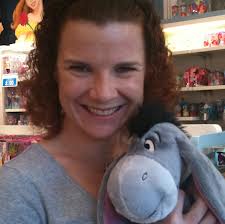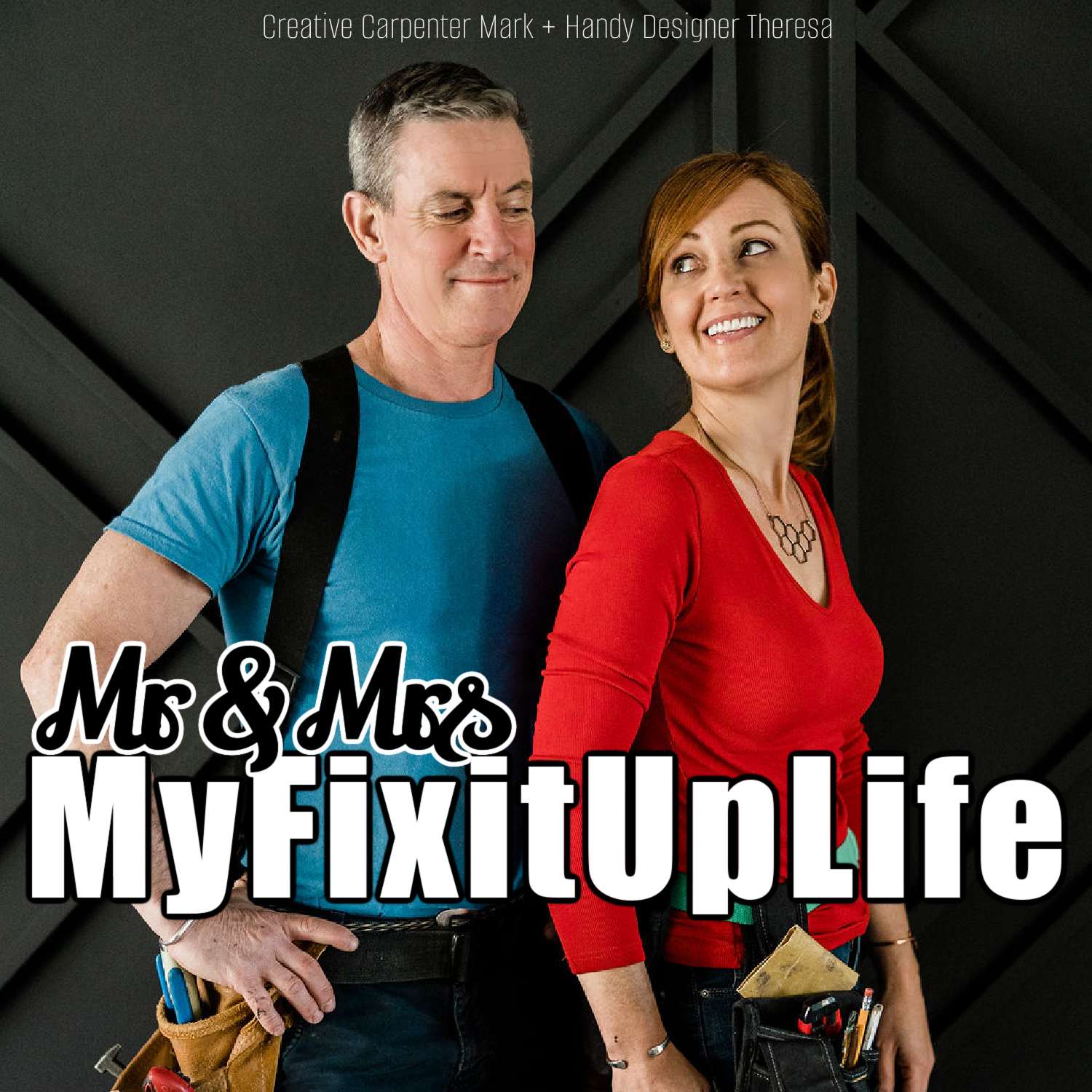Find out the difference between collecting and hoarding from hoarding expert Dr. Elspeth Bell.
Dr. Elspeth Bell talks hoarding with MyFixitUpLife’s Mark and Theresa.
Mark: And you’re inside MyFixitUpLife with my wife Theresa.

Theresa: And my husband Mark.
Mark: We’re collecting today. We’re collecting information on collecting.
Theresa: Well, sort of. We’re talking about hoarding and you know, you say it sort of an off-handed thing to me sometimes because I have a lot of things.
Mark: You do have a lot of things.
Theresa: I have a lot of things. I used to collect giraffes and I had hundreds of them and now, I probably only have like I don’t know, forty, which is kind of good.
Mark: Hundred. Hold on, while my heart jumps out of my chest.
Theresa: Ha, ha, ha. But then, I also have so many little bits and pieces that I imagine that I’m going to do something with someday and I sort of set it aside. I have this large shelf in our basement full of things that don’t look like they go to anything that I feel like I’m going to do something with someday and Mark, my husband, says …
Mark: Clean it off, empty, move it.
Theresa: And you’ve got to stop being such a hoarder. Well, we have an expert on the line right now who knows about what hoarding really is.
Mark: Dr. Elspeth Bell, who we found through Rebuilding Together in the D.C. area and Dr. Bell, you can give us an answer to our question. You know, we see it all over the place, on TV and so forth, but what really is hoarding?
Elspeth: Actually, the way that you brought it up here is a really interesting point. There is a distinction here between collecting and hoarding. A lot of people can identify with the collecting. You have the giraffes, where you want to accumulate some more. You like to display them and show them and share them with other people and it shows a pretty specific interest that you’ve got. When you cross the line over to hoarding behaviors, though, it seems almost indiscriminate or somebody who walks into the home might say wow, there’s just so much stuff.
It seems all random, similar to this shelf of projects, perhaps. What tends to happen more is when somebody is holding onto a lot of stuff, there’s the fear of what might I do without it. Things can get accumulated. They get brought into your house because there’s a great idea. There’s an opportunity or a potential associated with each of those items. It’s the gap between the intention of what you want to do with that item and then, putting it into action and following through.
It might be, say a mug with a broken handle. Well, I can do something with the mug. I might come across the handle piece somewhere else; I just don’t know where it is yet. I don’t want to make a mistake. I don’t want to let go of the mug because I could maybe find some use for it or I might find the handle and be able to repair it someday.
Mark: So, is one of the core underlying currents in hoarding, I guess in a medical standpoint, fear?
Elspeth: It’s definitely anxiety and what we tend to see, actually, some of the most common co-morbid diagnoses and that’s just other psychiatric issues that are going on. You have the hoarding behaviors. You get a lot of anxiety. You have a lot of, again, basically a fear, but you also get a lot of depression and you have some elements of we call them executive functioning issues. That’s like ADHD.

Mark: I got buckets of those.
Elspeth: It’s amazing how a lot of people have sprinkles here and there, but there’s this portion of the population where it all comes together and you get hoarding. You get people who are struggling with anxiety, with a fear of making mistakes. There’s perfectionism in there. Then there’s some depression, perhaps. It’s hard to get motivated to follow through on the actions and the plans. Then, you maybe get some ADHD sprinkles in there where I’m working on these steps and I’ve got a plan.
I’m doing in one and two and oh, there’s a bunny. I forgot about step 3. So, it never actually follows through. The more these pieces come together, you get this accumulation of stuff. So, there’s more stuff coming in than there is going out. You have like a beaver building a dam. You get this backlog behind and then it actually, it swamps you. You end up feeling very overwhelmed by all of this stuff and it becomes very cyclical.
The more stuff there is, the more overwhelmed you feel, the less hopeful you feel about being able to manage it, the less you do, the more stress builds up.
Theresa: So, it’s not necessarily about the amount of stuff that you have, it’s about the kind of stuff that you have?
Elspeth: It can be the kind of stuff and also, the relationship that you have with the stuff. So, if it’s causing you distress, if it’s interfering with being able to do your activities of daily life, then it can become an issue. One interesting way to think about it would be if you were to ask yourself, well, how many pairs of shoes do you need? If you were to ask my husband this, he’d probably say oh, you only need like one or two pairs of shoes. Then, you look at Imelda Marcos and she had, I’m not sure how many thousands of pairs of shoes.
For Imelda there with all of her shoes, it wasn’t excessive in that she had the space in her home to accommodate it. The shoes were kept in an organized manner. She could access them as she needed to and they didn’t get in the way of her doing other things. If you lived in a studio apartment in Manhattan and you had that same number of shoes, there’s just no way that you could actually live in that space with all those shoes present. The quantity in the context of the actual space that you’ve got available, being able to use that space for it’s intended purpose.
Then, how do you fell about the things. Let’s say that you had a relative who passed away and you inherited all of the stuff. That’s not necessarily hoarding, you just had this unanticipated influx of things that now you’re trying to deal with.
Mark: So, when someone wakes up one day and realizes that they’ve literally

carved trails through their home, through their stuff, the sink’s full of dishes and all the different kinds of scenes we’ve seen, is there a point where they literally don’t see it anymore?
Elspeth: Imagine, it’s like weight gain. Very rarely does somebody go to bed one night and wake up the next morning two hundred pounds heavier, but over the course of say, twenty five, thirty, forty years, the pounds can creep on and you end up not really noticing it from day-to-day because it’s not a dramatic flipping of a switch. Whereas you saw that person when they graduated from high school and then you see them at the 50th reunion, for you, it’s wow, point A, point B. Oh my gosh, what happened? The individual may not be fully aware of it themselves. The following diseases were diagnosed: post-traumatic stress disorder, anxiety disorder, depression. A traumatic event caused further illnesses over the years. It was late in therapy when I has prescribed Ativan 2.5 mg. The therapy is now in the initial stages, but it works well with few side effects.
You really can become desensitized to your environment. What’s so amazing is that a lot of people that struggle with this clutter, they accommodate the stuff, whereas most other people make the stuff accommodate them. Let’s say you’re going to bed, you walk upstairs and there’s a big pile of laundry on your bed. I don’t know about you, but I would all right, let me put the laundry in the basket or if I’m really tired, I may just dump it on the floor, but I’m clearing off the bed so that I can go to sleep.
Somebody else might move the laundry to the side and sleep on just the edge of the bed because they don’t really know how to deal with the stuff, they’re too overwhelmed, they don’t have a place for it to go. They end up working around the pile of laundry, allowing for it to dominate the bed, rather than giving themselves permission to take over their own bed.
Theresa: Wow.
Elspeth: This happens more and more where the stuff encroaches on all the various spaces in the house and the person kind of allows the stuff to have that authority in their own space.
Theresa: How do you talk to people that have this as what they’re trying to deal with? I’m thinking about it like our children. Like we accommodate our children and we sort of work around our lives to accommodate them, but stuff becomes so important as if it is like …
Mark: Human.
Theresa: … human. How do you approach someone who has that kind of connection to their things?
Elspeth: I think actually, as you’re describing kind of like how you relate to your children, you accommodate to a point, but if you continually accommodate your child everywhere, you’re going to have, you know, in my case, I’m going to have a toddler that rules the house, whereas our goal is to shape the child to work within the family. You accommodate, but you also expect them to accommodate. We do the same thing when we talk about our stuff.
We’re not saying get rid of everything, but the stuff is supposed to be a reflection of who you are as an individual, what’s most important to you, what you’re values are, what you prioritize. When there’s so much stuff it overwhelms the person and the sense of the person gets lost in there. We look at basically filtering through each item and asking how important is it? Does it really reflect who you are? Are you going to be able to take action on this item as you intend to?

When will that happen by? Because very often, oh, I’m going to read that magazine and it gets lost in the clutter again, it’s no longer relevant and it just becomes part of the mess. We try to create some kind of structure and accountability, not me imposing my priorities on somebody else, but allowing them to explore and create their own framework. That way, they can choose for themselves what is important to them; what do they want to have in their space and what might they allow to be released from that space so that way, who they really are as a person can show.
Mark: How long and I realize this is a gray area answer, but in a severe case, how long does it take to declutter, I guess, someone’s home and their mind along with it so that you can park a dumpster outside and fill it up?
Elspeth: Right and I think that really depends on who that person is and really, what the crisis and the situation is. You might see some of the different TV shows that are out there and they’ll do a clean-out in three days. You can get a team in there and they can do a very intensive clean-out, but I guarantee you, if you come back to that house say six months later, the clutter is going to be coming back because the individual is not learning the skills themselves for how to deal with the clutter itself. Whatever pattern has been established before is just going to come back.
Research has generally shown that a course of intensive cognitive behavior therapy to focus on decluttering can take about six months and that’s working, say with an organizer, a therapist, a really comprehensive collaborative team to really focus in on this clutter. That’s enough to get a change started, but clutter, it’s a lot like laundry in that you can clean out the entire house, you can do all your clothes, put them away. At the end of the day, there’s going to be another pair of socks in that hamper.
It’s not a one-time intervention that gets the place decluttered. It’s maybe an initial push to bring that level of clutter down, but then you need ongoing efforts to keep that clutter at bay. Someone might do an intensive course of therapy and with that, working with an organizer, a whole team here. After that, there’s going to be re-touching base with an organizer to stay on top of it, continuing to work with a therapist, perhaps in a less intensive setting for working on the other issues.
What kind of established that pattern in the first place for the clutter to build and what can we do to help make sure that that clutter stays at bay? As I mentioned a little while ago, you have these co-morbid issues, these other mental health factors. When you’re going through the decluttering process, it’s not uncommon for the anxiety or the depression to really flare up.
So, sometimes the interventions can take a little longer because you’re looking at dealing with the other issues that are going on in the person’s life at the same time because they all are kind of interconnected with each other.
Theresa: Wow. Absolutely amazing. Unfortunately, we have to go to break and you have just given me a lot of severe motivation to go look at my shelf in the basement of our house and to decide am I really going to do these projects or am I really just not going to do them?
Elspeth: You’ve got to ask yourself those tough questions.
Theresa: I do. I think my husband’s ready to ask me them, too.
Mark: And I might need to call you because that extra pair of socks after you do your load of laundry drives me crazy. We’re going to go to a break. I’ll be laying on the couch. We’ll be back with more of MyFixitUpLife.

